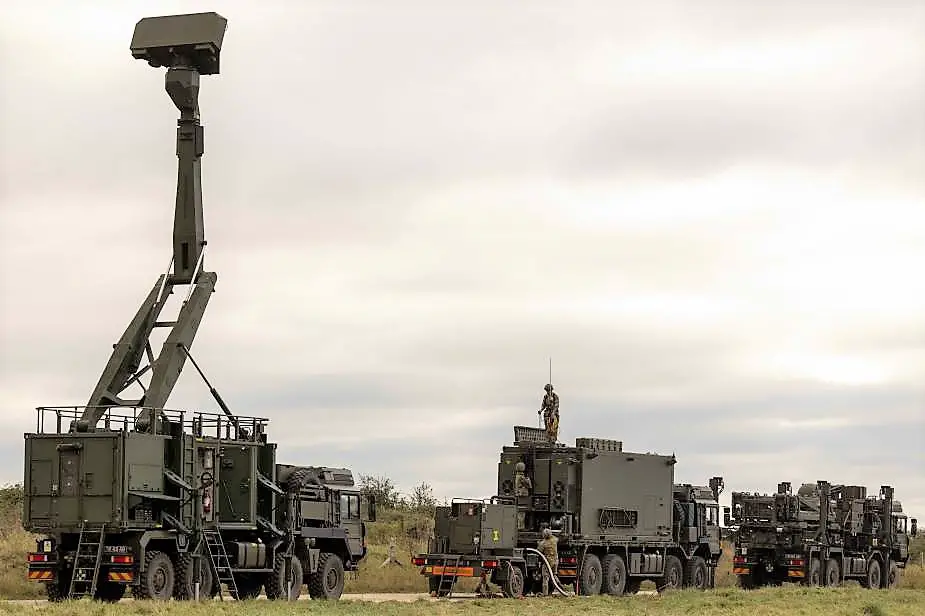The British Army is deploying its Sky Sabre air defense system on the disputed Falkland Islands (Malvinas, in Argentinian designation), a deployment against which Argentine is protesting. Indeed, the Falkland Islands, located in the southwestern Atlantic Ocean, have been the subject of a territorial dispute between Argentina and Britain for 200 years. The Falkland Islands are a dependent territory of the UK and will remain so for as long as the Islanders wish them to, British Army’s website writes.
Follow Army Recognition on Google News at this link

The Sky Sabre air defense system comprises three separate components. Although pictured together, in reality, in the battlespace, they would be expected to operate at distances of up to 15km apart. (Picture source: British Army)
In March 1982, Argentinean scrap metal merchants landed on the Falkland Islands' dependency of South Georgia and raised the Argentinean flag. This was followed by an invasion of the Falkland Islands on 2 April 1982. The United Nations Security Council condemned the invasion. The United Kingdom reacted by sending a Task Force to the South Atlantic and imposing a naval and air blockade on the large Argentinean garrison on the Falkland Islands. South Georgia was recaptured, and a large logistics and staging post was set up on Ascension Island to support the Task Force.
On 21 May 1982, British troops landed at Port San Carlos and began to move towards Stanley. They won a significant battle at Goose Green, which laid the foundation for victory. After an intense air and artillery barrage and the capture of dominant mountain ridges around Stanley, the Argentinean Commander on the Falkland Islands surrendered all his forces on 14 June 1982. After the 1982 conflict, the UK established a garrison on the Falkland Islands, consisting of naval, land and air elements.
The situation in the South Atlantic has changed substantially since the conflict. Argentina is now a democracy, committed to the peaceful resolution of issues over the Islands.
Sky Sabre air defense system
Sky Sabre, as the name implies, is very much at the cutting edge replacing its venerable predecessor Rapier which recently entered its fifth decade of operation with British Forces. Rapier has seen service in Kuwait, the South Atlantic, and probably most visibly when it deployed to numerous London parks to combat any security threats during the 2012 Olympics.
First of all, there are the eyes and ears of the system and for Sky Sabre that is the Giraffe Agile Multi-Beam 3D medium-range surveillance radar. Its radar rotates atop an extending mast which allows it to be elevated above tree lines and other obstructions to identify low-flying intruders. The Giraffe can see a full 360 degrees out to a range of 120km. It is a tried and very much trusted system that has seen numerous upgrades since it first entered service.
The second component lies at the very heart of the whole system; it is the Battle Management and Intelligence suite. In essence, the command and control centre. This capability links up the radar with the missiles and sends them to their targets. It also provides what is known as Link 16; this is a tactical data link that allows Sky Sabre to share its information with Royal Navy vessels, the Royal Air Force, and allies. It means that the system can be integrated wholly and contribute fully with joint, combined, or NATO operations.
Finally, the third component is the Land Ceptor intelligent launcher and missile itself. At 99Kg each, the missiles are double the weight of the Rapier it replaces and have three times the range. This is the Common Anti-Air Modular Missile (CAMM) that reaches speeds of 2,300mph and can eliminate fighter aircraft, drones, and even laser-guided smart bombs.
Sky Sabre’s CAMM is the same missile that is used onboard ships (Sea Ceptor) and shares components with the Royal Air Force munitions (ASRAAM). This commonality across all services brings with it huge logistical efficiencies as well as significant cost savings.

The CAAM missile launcher unit mounted on MAN SV HX60 8x8 truck (Picture source: Army Recognition)














